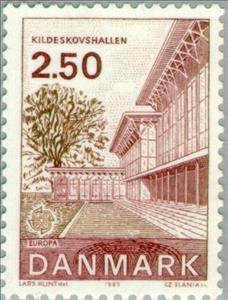Stamp: Kildeskovshallen Recreation Centre, Copenhagen (Denmark 1983)
Kildeskovshallen Recreation Centre, Copenhagen (Denmark 1983)
05 May (Denmark ) within release C.E.P.T.- Europe goes into circulation Stamp Kildeskovshallen Recreation Centre, Copenhagen face value 2.50 Danish krone
| Stamp Kildeskovshallen Recreation Centre, Copenhagen in catalogues | |
|---|---|
| Michel: | Mi:DK 781 |
| AFA number: | AFA:dK 778 |
Stamp is square format.
Also in the issue C.E.P.T.- Europe:
- Stamp - Kildeskovshallen Recreation Centre, Copenhagen face value 2.50;
- Stamp - Sallingsund Bridge face value 3.50;
Stamp Kildeskovshallen Recreation Centre, Copenhagen it reflects the thematic directions:
The European Conference of Postal and Telecommunications Administrations (CEPT) was established on June 26, 1959, as a coordinating body for European state telecommunications and postal organizations. The acronym comes from the French version of its name Conférence européenne des administrations des postes et des télécommunications.
The Europa postage stamp (also known as Europa - CEPT until 1992) is an annual joint issue of stamps with a common design or theme by postal administrations of member countries of the European Communities (1956-1959), the European Conference of Postal and Telecommunications Administrations (CEPT) from 1960 to 1992, and the PostEurop Association since 1993. Europe is the central theme. EUROPA stamps underlines cooperation in the posts domain, taking into account promotion of philately. They also build awareness of the common roots, culture and history of Europe and its common goals. As such, EUROPA stamp issues are among the most collected and most popular stamps in the world. Since the first issue in 1956, EUROPA stamps have been a tangible symbol of Europe’s desire for closer integration and cooperation.
A building or edifice is a structure with a roof and walls standing more or less permanently in one place, such as a house or factory. Buildings come in a variety of sizes, shapes and functions, and have been adapted throughout history for a wide number of factors, from building materials available, to weather conditions, to land prices, ground conditions, specific uses and aesthetic reasons. Buildings serve several needs of society – primarily as shelter from weather, security, living space, privacy, to store belongings, and to comfortably live and work. A building as a shelter represents a physical division of the human habitat (a place of comfort and safety) and the outside (a place that at times may be harsh and harmful).




